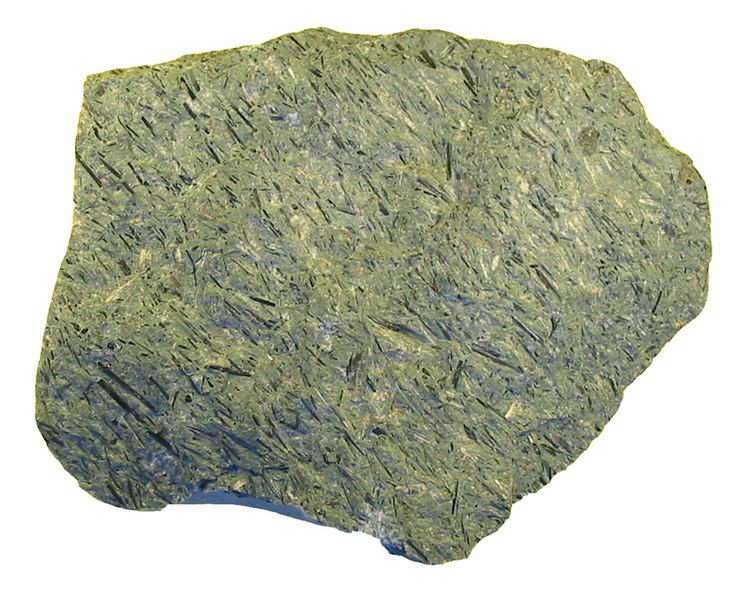 | ||
Phonolite is an uncommon extrusive igneous rock, volcanic rock, of intermediate chemical composition between felsic and mafic, with texture ranging from aphanitic (fine-grain) to porphyritic (mixed fine- and coarse-grain).
Contents
The name phonolite comes from the Ancient Greek meaning "sounding stone" because of the metallic sound it produces if an unfractured plate is hit; hence the English name clinkstone.
Formation
Unusually, phonolite forms from magma with a relatively low silica content, generated by low degrees of partial melting (less than 10%) of highly aluminous rocks of the lower crust such as tonalite, monzonite and metamorphic rocks. Melting of such rocks to a very low degree promotes the liberation of aluminium, potassium, sodium and calcium via melting of feldspar, with some involvement of mafic minerals. Because the rock is silica undersaturated, it has no quartz or other silica crystals, and is dominated by low-silica feldspathoid minerals more than feldspar minerals.
A few geological processes and tectonic events can melt the necessary precursor rocks to form phonolite. These include intracontinental hotspot volcanism, such as may form above mantle plumes covered by thick continental crust. A-type granites and alkaline igneous provinces usually occur alongside phonolites. Low-degree partial melting of underplates of granitic material in collisional orogenic belts may also produce phonolites.
Mineralogy and Petrology
Phonolite is a fine-grained equivalent of nepheline syenite. They are products of partial melting, are silica undersaturated, and have feldspathoids in their normative mineralogy.
Mineral assemblages in phonolite occurrences are usually abundant feldspathoids (nepheline, sodalite, hauyne, leucite and analcite) and alkali feldspar (sanidine, anorthoclase or orthoclase), and rare sodic plagioclase. Biotite, sodium-rich amphiboles and pyroxenes along with iron-rich olivine are common minor minerals. Accessory phases include titanite, apatite, corundum, zircon, magnetite and ilmenite.
Occurrence
Nepheline syenites and phonolites occur widely distributed throughout the world in Canada, Norway, Greenland, Sweden, the Ural Mountains, the Pyrenees, Italy, Eifel and Kaiserstuhl in Germany, Brazil, the Transvaal region, the Magnet Cove igneous complex of Arkansas, the Beemerville Complex of New Jersey, as well as on oceanic islands such as the Canary Islands.
Nepheline-normative rocks occur in close association with the Bushveld Igneous Complex, possibly formed from partial melting of the wall rocks adjacent to that large ultramafic layered intrusion. Phonolite occurs in the related Pilanesberg Complex and Pienaars River Complex.
Examples
Economic importance
Phonolites can be of interest as dimension stone or as aggregate for gravels.
Rarely, economically mineralised phonolite-nepheline syenite alkaline complexes can be associated with rare earth mineralisation, uranium mineralisation and phosphates, such as at Phalaborwa, South Africa.
Phonolite tuff was used as a source of flint for adze heads and such by prehistoric man from Hohentwiel and Hegau, Germany.
Phonolites can be separated into slabs of appropriate dimensions to be used as roofing tiles in place of roofing slate. One such occurrence is in the French Massif Central region such as the Haute Loire département.
